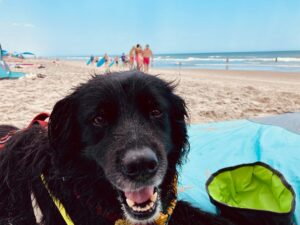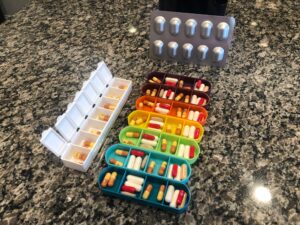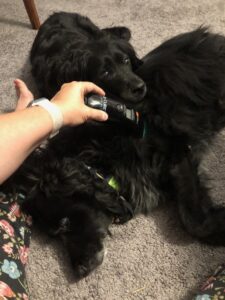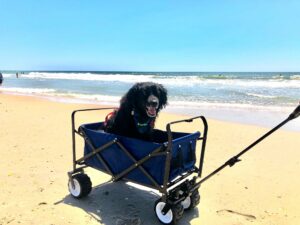 As I’ve written in the past, I currently share my life with two senior dogs. Mr. Barbo, who will be 14 in just 2 weeks and BooBoo will be 14 in October. And I know, as lucky as we are to have two large dogs reach these senior ages, it’s also heartbreaking.
As I’ve written in the past, I currently share my life with two senior dogs. Mr. Barbo, who will be 14 in just 2 weeks and BooBoo will be 14 in October. And I know, as lucky as we are to have two large dogs reach these senior ages, it’s also heartbreaking.
In the last year Barbo has struggled with significant medical issues from pancreatitis to tick illness to cancer. He’s been hospitalized twice and is on so many pills that we have two pill boxes, including one with 4 daily time slots. BooBoo recently has been struggling with her liver. We’ve done two ultrasounds this year and spent a night in the ER with her last month. It’s a constant roller coaster of highs and lows and the last few weeks have been hard for Barbo and we’re trying some new meds, but we may be approaching an end of life decision for him soon.
I’m keenly aware of quality of life and have made a promise that I will not let our dogs suffer. I’ve written about quality of life and grief resources here. They’re happy and we’ve made a lot of life changes to accommodate their needs to protect them and will continue to do so, as long as they’re happy.
Protecting my dogs and keeping them safe and happy is always my number one priority. Always.
So what changes have we made and how do we protect them?
- Medication and vet care. We’ve got a wonderful vet who has guided us about available medications that can help for pain, inflammation and anxiety (from pain, Barbo losing his hearing & possible cognitive issues). We’ve been through a whole host of trial and reassess to see what works, what doesn’t and played with doses and frequency. We’ve recently added in a new medication and that seems to really be helping Barbo lately. It’s a lot to manage but it’s keeping him comfortable and happy. Plus, we see our vet every 2 months on average for a recheck of blood and urine to monitor kidney and liver values and to discuss if changes need to be made.

- Mobile vet. Our new vet is a mobile vet – she comes to the house. We decided to make the switch from an office based vet to a home vet to reduce their stress (even though they were very comfortable going to an office), reduce them walking on slippery surfaces and when the time comes, to be able to euthanize at home. Mobile vets can be great options for elderly dogs or dogs who get particularly stressed going to a clinic.
- Environmental/household changes. We’ve added carpet runners on slippery floors. We open the door to let them out instead of always having them use the dog door, which requires them to step up over a lip, to get outside. We’ve started feeding on a washable throw rug, to give traction when eating or doing enrichment in the yard on the grass.
- Resting surfaces. Barbo has a particular affinity for loving hard surfaces. But hard surfaces are not good on aging, sore joints. So we invested in a Big Barker bed and a Ruggable for our back patio. Orthopedic or raised beds can make it easier for arthritic dogs to get up, since they’re raised up a bit and can slide or step into standing position without have to push themselves up so much. And the Ruggable gives him a little padding over the concrete patio and gives him traction. And it’s washable!
- Cold laser. I’ve invested in a home, cold laser system. (If you’re interested in one, you can use code lasala10off for 10% off your purchase.) This isn’t as powerful as vet-grade office ones but it’s much more convenient, I can use it on both dogs and it’s already paid for itself in the amount of time I’ve used it. And he really enjoys it! (And BooBoo enjoys “helping” when she’s not being lasered herself!)

- Adventure cart! For times when we suspect Barbo will get too tired or sore to walk as much as he thinks he can, we purchased his “adventure cart.” It has extra wide, sand tires, so we can use it on pavement and at the beach. This allows him to walk for as long as he wants or is able to, and then he gets a ride. And it enables him to still come with us like he’s used to on outings.

- Careful interactions with other dogs. Any interactions with unknown dogs are very carefully controlled. No puppies. Puppies are cute and rambunctious but they often jump on other dogs and with senior dogs having arthritis and weakness, this can be a disaster. We walk where leashes are required and I am extremely proactive about any off-leash dogs and will loudly yell to other owners to put their dog on leash in these areas. I do not want an off leash dog, even if friendly, rushing up and accidentally knocking Barbo over or trying to play.
- Grooming. I’ve always been attentive to grooming, especially nail care but in their senior years, it’s especially important to maintain proper nail length and trim the fur between toes and pads, so they have the best traction possible and so they’re not overcompensating and shifting their weight or walking with an odd gait because of instability.
- Gear change. We recently changed to a new Ruffwear harness that doesn’t require lifting up front legs to put the harness on. It just slips over the head and then the chest strap goes under and the straps go around the torso to buckle. It reduces needing to put extra shoulder and elbow lifting every time they need to be harnessed. And it has a lift handle (normally intended for giving your pup a lift during hiking) that we can use to stabilize or help lift into and out of the car.
- Enrichment. I’ve written about how enrichment isn’t optional. It’s about meeting needs. So beyond physical needs seniors have, we need to ensure that while they may not get as much physical exercise, we’re giving them other opportunities to use their skills. Low impact “sniffari” walks, food toys, kibble scatters in the yard, easy training (usually just practicing skills they already know) and car rides.
- Time. We know our time is limited and in Barbo’s old age, he’s gotten more social, seeking out attention more than his youth and we 100% indulge him when he asks for pets or other attention. I spend a lot of time on the floor, because it’s easier for him than trying to jump on the couch to be near us. Enjoying every moment you can will help when they’re gone. You never will say when they’re gone, I wish I spent less time with my dog. While some people wait until they’ve received terminal news to make a doggy bucket list, we actively work to incorporate fun activities with them every day. They’ve been our constant companions for over a decade and every moment is precious, but especially when life could change in an instant. That’s a good life lesson for us too.
Protect the seniors.
If you’d like some training or enrichment ideas, or are struggling with behavior issues with your senior, I’d love to help you. You can schedule a session here.
Love to all the seniors and their caretakers, Protect the seniors.
![]()




